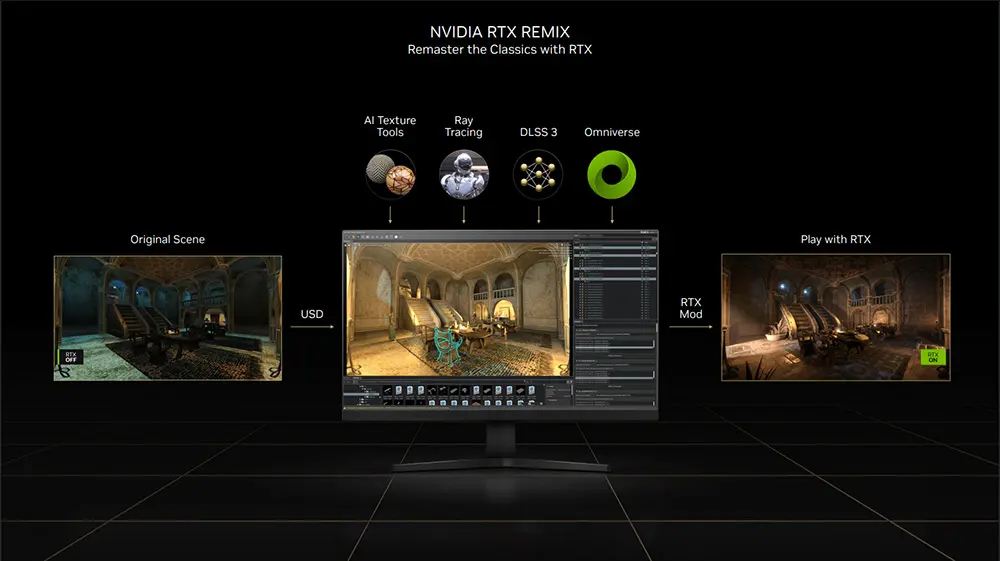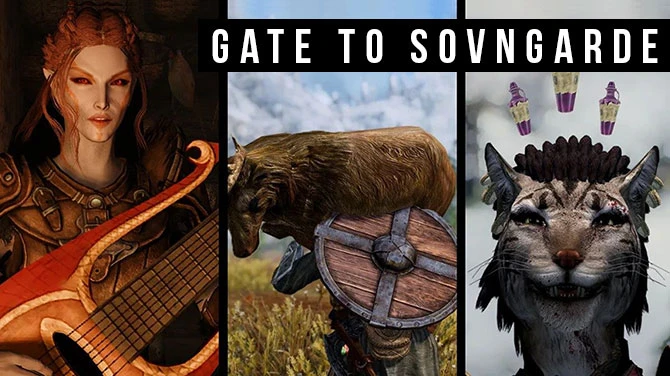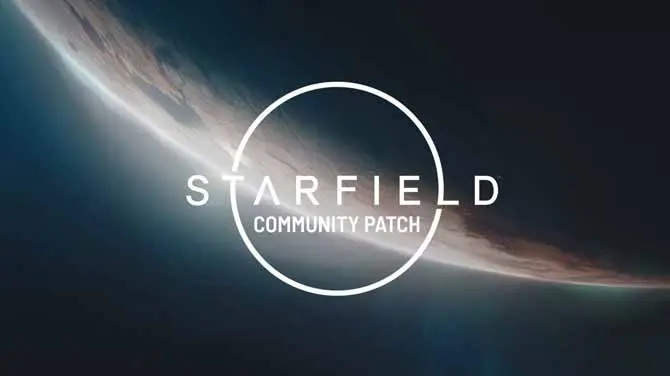If you're not up to speed yet, here's a clip from the keynote and the video above provides an in-depth look at how it works.
NVIDIA RTX Remix is a free modding platform built on NVIDIA Omniverse that vastly expands the modding capabilities of compatible DX8 and DX9 games. With Remix, modders can use a combination of AI texture tools and their own artwork to replace textures, objects and materials with high-quality versions. It also allows modders to inject modern lighting techniques like ray tracing, DLSS 3 and NVIDIA Reflex into the game.
Perhaps the biggest and most exciting thing about RTX Remix is that it effectively enables modding for titles that were either harshly limited or almost impossible to mod beforehand!

So how does it work? Modders can start the game with RTX Remix running alongside it and at the press of a button, all the render data for textures, geometry and lighting data is captured and converted to the Universal Scene Description (USD) format which is then loaded into the application. From there, modders will be able to replace assets, update textures and tweak the lighting to their heart's content. It also features AI-assisted upscaling tools to supplement the modder's workflow. Once they're ready to share what they have created, all the changes can be bundled into an RTX mod.
For players, you simply install the RTX mod near your game executable and when you boot up, the changes made in Remix will be automatically applied. That's not all though. RTX Mods will also include an in-game configuration menu that allows the player to tweak lighting, reflectivity and other values on the fly to achieve their desired effect.
RTX Remix will require modders to be using a ray tracing capable NVIDIA GPU to create the content (RTX 20 series or above) but players can install and play RTX mods with any GPU that supports Vulkan Ray Tracing.
You can see a great example of what's possible with RTX Remix by looking upcoming Portal RTX trailer or the Morrowind RTX Mod showcased during the keynote. There's no confirmed release date yet, but we're optimistic that you'll be able to get your hands on RTX Remix sometime in early 2023.
NVIDIA is excited to see how modders will take advantage of RTX Remix and has joined us in this post to answer your questions from the comments. Before we get to that though, here's a word from Nyle.
Thanks Nexus Mods. Modders, we are working hard to make sure you don’t have to wait long to start creating with RTX Remix. When we made Quake II RTX and saw all of the amazing things the community built off of it, it was eye-opening. We knew our next project had to be more than an RTX remaster–it had to more importantly enable the community to apply their undeniable creativity to the diversity of classic content that is out there. From the games that have been difficult to mod, to community favorite titles and existing mods–RTX Remix has the possibility to reimagine all of these experiences in beautiful path tracing with high quality assets. We can’t wait to see what jaw dropping remasters and remixed mods you will create with this powerful tool. And with that, please feel free to ask whatever questions are on your mind, but please understand that I’m here to share more on RTX Remix and Portal With RTX and am not in a position to speak to other topics (GPU availability, price, performance for example). We can’t unveil everything just yet since RTX Remix is still deep in development, but we will do our best to answer all that we can.
To ask a question, simply leave a comment on this article - please take a minute to scan the existing comments so that we avoid too many repeated questions. Nyle will answer as many as he can, but please keep in mind the topics they can and can't discuss!
Don't worry about digging through the comments for answers though, I'll be adding a copy of each question and answer to the spoiler in the pinned comment below.








98 comments
Comments locked
A moderator has closed this comment topic for the time beingUntil next time,
Nyle Usmani
NVIDIA Product Manager
1. This is more of an expansion of the previous question posed by dariort64, more specifically the part about LOD’s.
Would it be possible to completely subvert/ignore the base games LOD system and simply set up our own LOD hierarchy through RTX Remix?
This way the artist could go through and set their own performance target with mesh specific LOD distances catered to their custom assets.
2. This question ties into the first question a little. Would it be viable to give artists the ability to create “proxy” meshes for
the path tracer to use in reflections or to manually target a specific LOD to be used in reflections.
(or maybe just use the original games geometry for reflections)
3. Is it possible to override a mesh/s culling to prevent it from ever being culled or set custom parameters that would dictate when an
object will be culled in order to facilitate more efficient and or better reflections in the path-tracer?
This would allow artists to decide what geometry stays rendered in the scene, regardless
of what the base game intends.
4. I know that you guys will be validating games on you’re end, but will end-users be able to attempt to use RTX Remix with any DX8/9 game
they chose? I know similar questions have already been asked but I couldn’t find any definitive answers on this.
5. This question is more of a stretch but have you guys ever looked into a “virtualized geometry system” similar to UE5’s Nanite solution?
It would completely eliminate the need for LOD’s (and allow absurd triangle densities), but I am well aware that that is in no way a trivial task.
What Epic managed to achieve with Nanite is borderline voodoo magic.
so in short my question is. would it work on games that have a lower direct x but also say lower direct x and above for example DirectX 6.0 and above?
We look forward to seeing your future experiments with RTX Remix! On to your questions:
As long as players have the RTX Mod with remastered assets, they will see the maps with updated visuals. The server is uninvolved in the rendering process and is not relevant to whether users will see updated visuals–it’s all about the RTX Mod users have locally stored on their PC. Because the RTX Remix runtime is only influencing the visuals, players should in theory be able to play against each other even if some players are seeing the vanilla game while others are using RTX Mods.
To correct a misconception, you may not have to remaster every custom map. In old games, many custom maps reuse the same textures and assets. RTX Remix should replace all of those textures and assets if the mod has replacements available, even if the level geometry is being seen for the first time.
As for dynamically downloading RTX Mods in game for players who do not have those assets already–that type of functionality would have to be modded into the original game by the modder so that remastered assets are downloaded and put into the RTX Remix Runtime's asset folder. RTX Remix wouldn’t be involved in architecting such a system.
Another thing to note–Anti-cheat software may prevent RTX Remix from working in certain competitive multiplayer titles.
Will it be possible to make custom implementations of the shading of surfaces (e.g. shader programming) to be able to recreate specific materials more easily?
How will the USD replacement functionality work with skinned assets? Or will it only support static mesh replacement? Will assets that use vertex blending be exported with their matching bones and weights correctly? And what about games that use morphers for facial animations?
What kind of scripting functionality will be available to control what lighting or other scene settings get used in a game? Would this provide a way to modify the scene in real time to match certain systems of the game (like a game with a dynamic day/night system)?
Will there be any systems in place to deal with replacing assets in games that are capable of streaming and swapping different level of detail meshes?
Very detailed questions!
For GPU based (fixed function) skinning, we actually have access to the pre-skinned mesh and the skeleton (including the collision volumes for raytracing) which gives us a great deal of flexibility to modify and reskin characters in RTX Remix.
We saw some (incorrect) speculation that we did not include NPC’s in our Morrowind RTX showcase because we weren’t able to properly mod them. But Morrowind actually passes us pre-skinned meshes and the skeleton so it was perfectly in our capabilities to modify the NPCs. In order to give the artists time to do an incredible job, we narrowed the scope of the project to an indoor environment without NPCs.
For the modder, they have two options. Recreate all three assets with different levels of detail to give you a similar feeling as the original game. Or map a high quality asset to all three instances, which would help make the asset feel more at home in a modern graphical context.
Hope that helps Dario. Can't wait to see what you can do with RTX Remix!
Notably for Nexus, New Vegas and Skyrim.
What I'm really, really hoping is the case, is that it will only take some extra work to make games like that fully RTX-ready, perhaps missing out on some automated stuff that Remix would otherwise do, but I'm afraid that it will simply not work.
Additionally, I saw in the previews that they were always shown off indoors, and with no NPCs or other dynamic objects. It can obviously handle at least some dynamic stuff given Portal with RTX's cubes, pellets, turrets, and things, but with Morrowind, there were no NPCs, and the outdoors was never shown outside of a vanilla shot for comparison.
How does Remix handle games which have a dynamic day/night cycle, and which load/unload objects dynamically in a single area (Such as exploring the worldspace in Morrowind and travelling to different cells)? How is it able to differentiate between indoors/outdoors? Can you specify an object or vector as relating to the sun/moon, and have it adjust RTX parameters dynamically to match?
Another thing is how it would deal with games that use culling. Will objects behind you stop casting their shadows because the game engine is no longer rendering them? Can it catch the whole scene in one go with that regardless, or would it require multiple 'snapshots'?
I love technical questions like this.
For dynamically loaded objects, as long as the capture properly includes each object that is dynamically loaded in and out of an area, the replacements should also dynamically load.
As far as day/night cycles go, that’s a trickier question. Assuming the celestial bodies are coded as directional lights, the ray traced conversion should retain that feeling of dynamic day and night cycles with more realistic shadowing and skies. From our outdoor tests in Mount and Blade: Warband, we’ve seen some stunning sunsets and sky lighting with realistically rendered light rays peeking through clouds–it’s entrancing to see that kind of thing in games from the 2000s!
If it's a lit skybox it should also work. But developers in those days took a lot of shortcuts to simulate a lit sky and there might be certain approaches to doing classic lighting that we haven’t seen in our testing, and therefore haven’t yet addressed.
As you’ve noted, if culling causes objects to cease to exist in the original game, then the RTX Renderer would also cease rendering them. Portal has built in settings that let us disable a lot of the more aggressive culling, which lets us avoid most of those issues. It still culls lights very aggressively, so we had to implement persistent static lights even after the game stops drawing them. There are other workarounds of course–for example, we can simply attach new static lights to level geometry and disable the original lights to retain the original game’s feel without breaking the immersion of full ray tracing.
If other games don't allow customizing the culling settings, and the issue can't easily be addressed by traditional modding, then we may need to look into implementing a different system. For example, some kind of caching to improve object permanence. There are many paths to a solution and we will be paying attention to see if this becomes an issue for classic games.
We did not get to every one of your questions but hopefully this demystifies things quite a bit. I should point out, another poster asked about skinning and NPC's, so definitely take a glance at the summary that Nexus Mods will post to see how RTX Remix handles that.
Btw, Killer7 was one of my favorite games on the Gamecube (always hoped the Smiths would make it into Super Smash Bros).
As such, in place of non-RT global illumination, volumetric lighting, and screen space reflections, RTX Remix offers highly customizable light accurate global illumination, volumetrics, and on/off screen reflections.
There are some post effects that are non-RT that allow modders to tweak the experience like bloom, tone mapping, motion blur, but the focus is to empower modders with higher fidelity lighting.
How are skinned/animated objects tracked? Are they replaceable?
Currently there is no such API but if there is interest for something like this, we can look to see if there’s anything we can do.